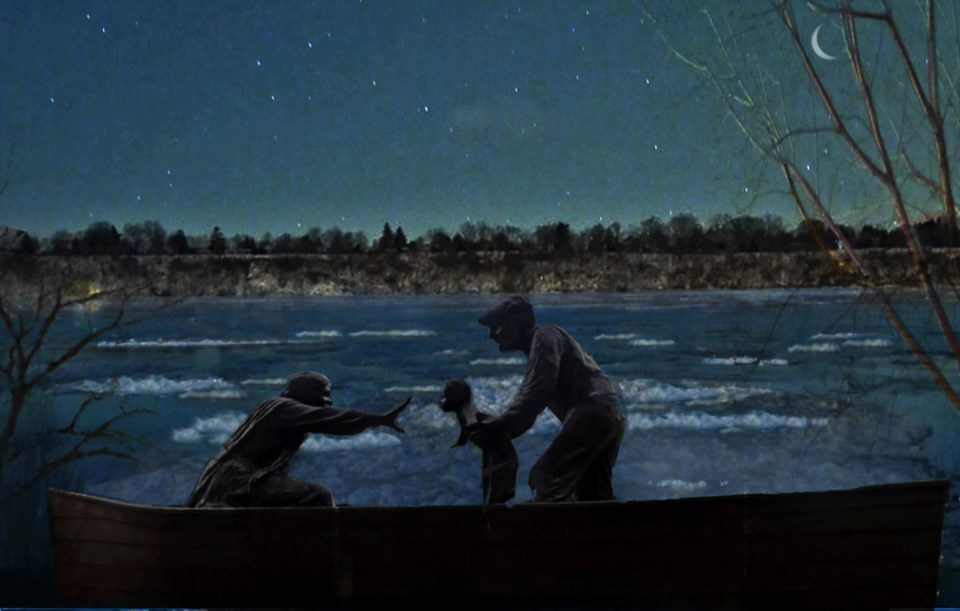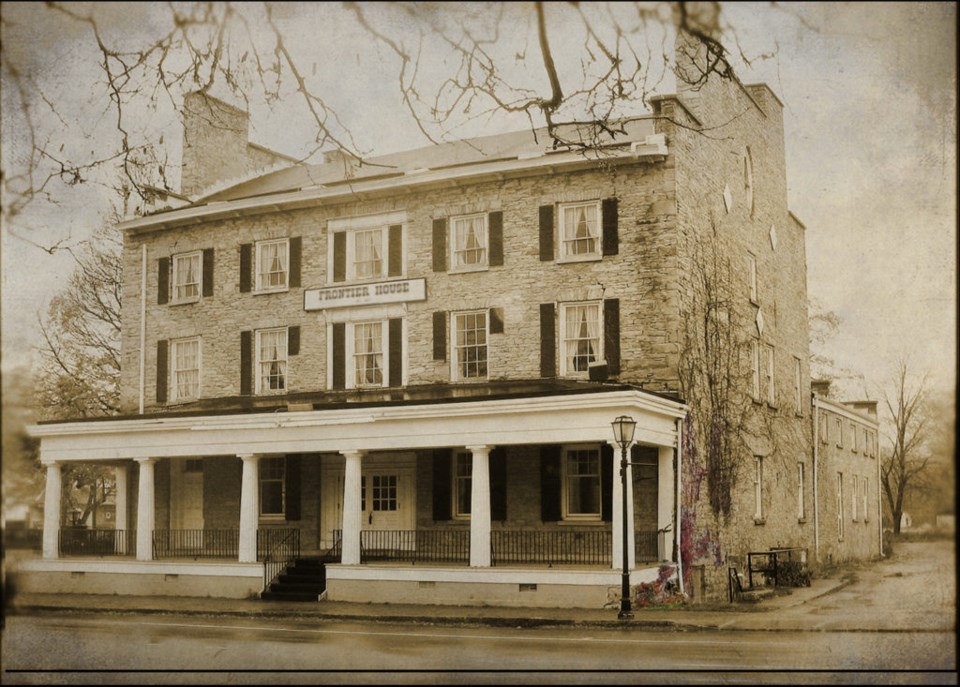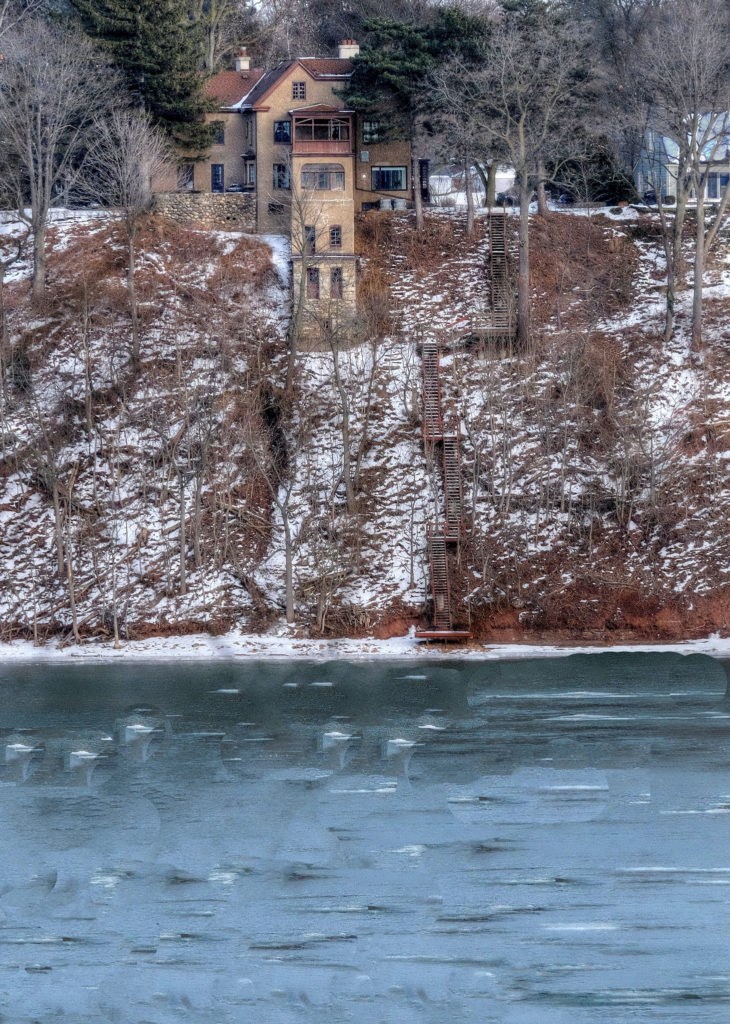
Jane Andres, best known in Niagara for her work helping offshore workers, says although she has spent her entire life in Niagara, “I possessed only a few dusty facts regarding the history of the U.S. side of the river. I had vague recollections of the story of the Tryon house, but it wasn’t until I spotted it from the Niagara Parkway close to Queenston in March 2020 that I became intrigued. My research over the past 11 months has been fascinating, and challenged me in ways I hadn’t expected. In this story, I wove together the facts in a way that stays true to the historical narrative, with only a few careful liberties taken.”
The bartender is in on it.
The livery owner and his crew are in on it too.
Enjoying his morning tea behind the stately porticos of his mansion overlooking the Niagara River, Major Benjamin Barton was in on it from the beginning.
The ladies from the weekly church sewing circles are in on it. Although known for their tendency toward salacious gossip as they stitched scraps into warm blankets, they kept the secret.
The ministers at Lewiston’s First Presbyterian Church and Episcopal Church are in on the “Holy Hush.”
Even Major Barton’s young grandchildren are in on it. On this snowy Saturday in early February, 1837, they are playing with the family dog in the front yard. They pause to watch a rider guide his exhausted horse over the frozen ruts of the main street to the livery.

The rider eases his aching bones out of the saddle, his fingers practically frozen to the reins. The livery owner comes to greet him and they engage in conversation for a few minutes. He points the rider in the direction of the Frontier House, a nearby inn that offers a hot meal, a bath and a comfortable bed to weary travellers. With stiff legs, the traveller stumbles off to the hotel.
Leading the horse away, the livery owner beckons to a young boy cleaning out the stalls. He whispers low and urgently, “tell Mr. Josiah he’s got some business coming his way.”
The young man takes off lickety-split around the corner, dodging pedestrians and carriages on the main street to a modest wooden structure that houses a tailor shop.
The tailor, Josiah Tryon, and his assistant are working on a large table close to the window. They see the young man approach before bursting in through the door breathlessly. Josiah already knows what this will be about. Exchanging his work apron for an exquisitely tailored, boldly coloured jacket, he ambles casually down the street and up the steps of the hotel.
The staff greet Josiah with warm familiarity and he settles in at the bar of the dining room. At the table next to him is the traveller. The earthy aroma drifting through the room advertises the fact he is wearing the same clothes for the four weeks he has been on the road.
After devouring a big bowl of stew, the traveller strikes up a conversation. He cautiously shares a few details of his “business” trip with Josiah, but cannot take his eyes off of the magnificent jacket. He can practically feel the reward money in his fingers, and a garment like this will be the first thing he is going to indulge in.
He enquires about the tailor who had crafted such a fine garment. Josiah acknowledges it is his handiwork, and beams with pride. In fact, he has a jacket that would be a perfect fit, with just a slight alteration. Josiah extends an offer to join him and his wife at church the following morning, and says he would bring it along.
The traveller cannot believe his luck. It would be a perfect place to meet the good people of the town, and make some enquiries as well. A soak in a hot tub tonight, a good meal, fine clothes waiting — how could a successful mission not be around the corner?
The next morning the horses and buggies are gathering at Lewiston’s Presbyterian Church. The new bell tower is gleaming so brightly in the early morning sun that folks can see it clear across the Niagara River. The church building project is near completion, and it is the congregation’s first Sunday enjoying the comfort of new pews, instead of rustic board benches.
Josiah greets the traveller inside the door, and presents him with the jacket. He eagerly tries on the new garment, a striking royal blue and a perfect fit. Introductions are made, and compliments flow, as 85 members of the congregation file past them into the sanctuary.
The pastor greets his church family, offering a special word of introduction to the traveller, who stands proud as a bright blue peacock.
After the service, everyone is so friendly, with plenty of opportunity for enquiries on both sides.
The traveller offers them a description of an enslaved man, a fugitive who fled with his enslaver’s horse back in his home state of Kentucky. The traveller would be staying the next few days at the Frontier House, and would be much obliged if anyone could offer assistance or possible tips on the whereabouts of the man he was seeking. They empathize with the bounty hunter’s story, and tell him they hope he will feel at home in their town.
He declines an offer for dinner, instead opting to head down river to Youngstown for the afternoon while the weather is favourable.
Josiah, his wife Mary and a small cluster of parishioners engage in conversation with the minister after the horse and rider disappear towards the river road.
No doubt about it, the pastor states emphatically, there is a fresh wind of the Spirit blowing in this congregation.
The previous summer a young preacher from Rochester by the name of Charles Finney had visited their congregation. He had preached a mighty sermon, challenging the congregation that if they consider themselves to be Christians, their daily lives must reflect Jesus’ command to love their neighbour as themselves.
He had greatly encouraged them, sharing news of endeavours similar to their own spreading to congregations across New York, Pennsylvania, and Ohio.
The spark that Rev. Finney’s sermon had ignited in the small congregation had grown into a steady flame, and a beacon of hope for many.
The small group bows their heads in prayer in the shadow of the church and asks for God’s protection for the plans unfolding later that evening. The pastor’s wife withdraws two child-size quilts from under the folds of her shawl, and hands them to Mary. An elderly Black woman, an employee in the kitchen at Barton’s Inn, slips in beside her, informing her that fresh loaves of bread were tucked under the blankets of their carriage while they were in church. Mary is filled with fresh resolve as she views the long, angry scar on the senior’s cheek, the result of a branding she suffered as a young woman, punishment for attempting an escape.
As the group disperses, the pastor entertains a worrisome thought.
He wonders to himself how long a town of over 200 can keep the Holy Hush.
…………
Josiah and Mary are deep in thought as they guide their horse toward home after the church service.
It’s been more than two years since they bought the house at the edge of the Niagara River from his older brother Amos Tryon, son-in-law to Major Barton. The two-storey home possesses a stately elegance befitting the social status of the wealthy Barton family. Folks in town call it Tryon’s Folly, because Amos had built it for his young wife, Sally Barton. According to local gossip, Sally refused to move there from their comfortable home in town. Raising 10 children necessitated living as close to familial support as possible.
But there is more to it than that.

Tryon’s Folly is also known as The House with Seven Cellars, one of the most unique homes to grace the banks of the river. A hidden passage and series of cellars connected by steep interior stairwells cascade down the steep banks of the river.
It is a strategic link in a vast network of “stations,” providing freedom seekers with safe passage to the British colony.
Although refugees had been following the north star for many years, it wasn’t until the British colonies abolished slavery in 1834 that the trickle of freedom seekers became a steady stream.
Hot in pursuit, an increasing number of bounty hunters also arrived in towns along the Niagara River, intent on cashing in a handsome reward for the fugitives.
Benjamin Barton and his company owned the rights to both Lewiston’s ship landing, and the portage route up the escarpment. The area was also a prime location for bounty hunters to watch for potential escapees.
The Tryon house was located about 600 metres downstream, making it much more difficult to spot a small rowboat crossing the river after dark.
In 1835, Josiah and Mary opened the home to strangers, a code word used for the refugees arriving in towns along the Niagara River. Lack of identification provided an added layer of protection for both the freedom seeker and the people harbouring them.
After collaborating with a loose network of abolitionists in nearby towns, Josiah came up with a plan to use his tailoring skills to further what he considered to be God’s work.
He would create a number of exquisitely tailored, brightly coloured jackets expressly for the purpose of giving them to the bounty hunters, after befriending them at the local inn where they stayed. This creative way of identifying bounty hunters quickly became known all along the Niagara frontier on both sides of the Niagara River, from Youngstown and Niagara-on-the-Lake to Niagara Falls and Buffalo.
The entire town of Lewiston collaborated in this holy hush to help those escaping bondage reach Canada safely.
Josiah attends to the horse, while Mary hustles into the house carrying the loaves of bread, and the quilts. He surveys the scene past the steep banks behind their home, to the stunning view of the Niagara River. A thousand hues of aquamarine and turquoise are further enhanced by the brilliant white of thick ice floes swirling in the swift current.
He ponders the irony of having to rely on former adversaries just across the river, who only 20 years earlier had completely destroyed the town of Lewiston, murdering defenceless adults and children alike, all the way from Youngstown to Buffalo. Now, people on both sides were dependent on each other in their journey towards justice. Complete trust was necessary to ensure not just the safety of those who were fleeing, but also the residents on the U.S. side who were disobeying federal authorities in order to follow a higher law.
Josiah’s sister Sally is helping in the kitchen. She removes a large pot of soup from the fire, gathering bowls and utensils. Mary draws the curtains closed and lights a small coal oil lantern. Together they make their way down a steep, windowless stairwell into a lower chamber. They begin pulling a crate piled high with bolts of cloth out of the corner, revealing a hole in the wall above the floorboards.
Mary gives three short raps on the wall. They hear a shuffle and a low voice murmurs from the other side. She slides the wrapped bread through the hole, followed by the pot of soup, bowls and utensils. She offers the quilts through the same space, enquiring after the children, and instructing them to get some rest to prepare for their last leg of the journey.
After his meal, Josiah retires to the bedroom to try to rest for a few hours. He struggles to fall asleep, and a wave of panic engulfs him as he drifts off, dreaming that he is drowning in the icy waters of the Niagara.
Despite the fact that he has been making night crossings on the river for two years, it never gets easier. The challenges grow exponentially during the winter with the added risk of lake effect snow squalls, ice jams and hypothermia threatening refugees already considerably weakened by their long journeys. He’d heard the stories of other boats trapped by converging ice floes, and forced to drift blindly under the black of night. Some eventually made their way to safety in Newark after hours adrift, but he knew there were others who were not so lucky.
While Josiah wrestles with his anxieties, a face peers out from the window of the lowest cellar. It disappears for a second, and then there are two faces, after the stranger’s seven-year-old son begs to be lifted up for a view.
Tears fill his wife’s eyes as she takes a turn at the window. This is their first view of freedom, a sight that will be embedded in their memories for the rest of their lives. She gathers up their two-year-old in her arms that they may share that glorious sight as a family. She caresses her daughter’s arms, overflowing with gratitude that they will never know a whip or chain. She tucks the little arms back into the depths of the warm quilt Mary gave her. She traces her finger along the decorative stitching, and admires the deep rich colours. Her favourite was a blue as brilliant as the waters of the river before her, the colour of freedom.
Rested and energized, they enjoy one last meal together, served by their hosts, this time joined by Josiah.
They are reassured by the kindness in his eyes, and the warmth of his presence as he explains the plans for the evening and instructions for the other side — if all goes well.
At 9 p.m. they hear the church bells tolling. What they do not see is a large, reflective lantern, the signal being lit in the western window of the bell tower of the Presbyterian Church.
Mary and Sally meet them in the large room at the lowest level, providing a thick wool cape and a large winter coat, along with a small sack of biscuits and provisions. They gather in closely, uniting their hearts in prayer for safety in the crossing. Tears, hugs, and hope permeate the atmosphere as Josiah cautiously opens the door a crack.
The dim glow of a lantern appears far off on the west shore of the river. It is time. The stairs carved into the steep banks are buried in snow. They have to cling to a rope to guide them down 60 feet to where the rowboat awaits. Overhead the north star beckons, as it has for their entire journey.
Josiah carefully guides mother and daughter in first, holding the small vessel steady. The father wraps his arms protectively around his young son, and closes his eyes after settling in. It is terrifying now that they view the ice flowing by so swiftly between them and the distant shore.
“Keep your eyes fixed on the light,” Josiah instructs them, “God is with us.”
He unhooks the rope from the dock and starts to pull on the oars.
…………
Thousands of enslaved men and women made their way to this final crossing to freedom, until slavery was officially abolished at the end of the Civil War.
Josiah Tryon was referred to as the man with the rainbow heart, because his jackets were the colours of the rainbow, and he enthusiastically embraced people of all creeds and colours. When he died in 1886, there was little left in his estate to pass on. Everything had been reinvested in the cause of freedom.
In all of those years, the people of Lewiston never betrayed the Holy Hush.
Tryon’s Folly still stands on the banks of the Niagara River.
Visit the Historic Lewiston’s website for more information - http://historiclewiston.org


